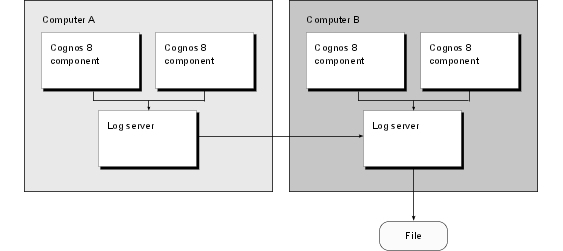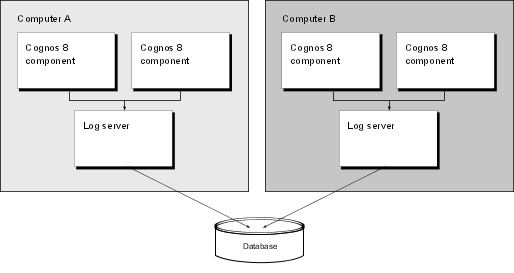
Log messages are an important diagnostic tool for investigating the behavior of Cognos 8. In addition to error messages, log messages provide information about the status of components and a high-level view of important events. For example, log messages can provide information about attempts to start and stop services, completion of processing requests, and indicators for fatal errors. Audit logs, which are available from a logging database, provide information about user and report activity.
The Cognos 8 services on each computer send information about errors and events to a local log server. A local log server is installed in the c8_location/logs folder on every Cognos 8 computer that contains Content Manager or Application Tier Components. Because the log server uses a different port from the other Cognos 8 components, it continues to process events even if other services on the local computer, such as the dispatcher, are disabled.
The following workflow shows the tasks that are required to prepare for logging.

 | During planning, determine the logging configuration that is suitable for your environment. For example, evaluate various log message destinations, such as remote log servers and log files, such as the UNIX or Linux syslog or the Windows NT Event log, in addition to the local log file. You can also send only audit logging information to a third-party database. Consider security, such as methods available for protecting log files from system failures and user tampering. For information about planning, see the Architecture and Deployment Guide. |
 | During configuration, define the startup properties for logging, such as connection settings for third-party databases. You must also create a logging database if you plan to collect audit logs. If communication between a local log server and a remote log server must be secured, make the appropriate configuration changes on both Cognos 8 computers. For information about configuring logging, see the Installation and Configuration Guide. |
 | When setting up logging, specify the level of detail to log to focus messages on the information that is relevant in your organization. Audit reports may also be set up to track user and report activity. For information about setting up logging, see the Administration and Security Guide. |
For information about using log messages to solve problems and resolving logging-related issues, see the Troubleshooting section of the Administration and Security Guide.
Distributed installations of Cognos 8 have more than one log server. With distributed installations, you can send log information to a central location. For example, you can configure Cognos 8 to send log information to a common log server. This log server sends the log information to a single destination on the same or a different computer.

You can also configure Cognos 8 to send audit log information from each log server to a common database. The common database can be on the same computer as one of the log servers, or on a different computer.

The local log server provides failover and recovery processes in the following three circumstances:
When the local log server is configured to send log information to a remote log server that is not available, log information from the local log server is stored in local recovery files. When the remote log server becomes available, an automatic recovery process moves information from the local recovery files to the remote log server, and deletes the local recovery files.
When local Cognos 8 components are configured to communicate with the local log server using a TCP connection and this connection is not available, log information for these local components is stored in local recovery files. When the TCP connection becomes available, an automatic recovery process moves information from the local recovery files to the remote log server, and deletes the local recovery files.
When a log server is configured to send audit log information to a database, and the connection between the log server and the database fails, no information is logged in the database. When the connection is restored, information about the connection failure and restoration is stored in the local log file, if it exists, and the log server resumes sending new log information to the database. This information stored in the local log file is not stored in the logging database.
For information about specifying where to send log messages and configuring TCP connections, see the Installation and Configuration Guide.
In a default configuration, the local log server on each Content Manager or Application Tier Components computer writes log messages to a local file. Configurations that consolidate the contents of individual log files may improve usability and performance.
Consider consolidating log messages produced on each
Cognos 8 computer by sending them to a remote log server. Configure
the remote log server to send all messages to a single log file
or to send audit logs to a database  .
.
Log messages may be easier to interpret if all messages from each Cognos 8 computer appear in a consolidated location. For example, the log messages can then be sorted by their timestamp to determine the order in which events on various Cognos 8 computers occurred.
If you are using a database to capture audit log messages, performance may be improved if you route all audit log messages to a single log server that sends messages to the database. If a single log server is not used, the local log server on each Cognos 8 computer would require its own connection to the database.
Another benefit of using a single log server with a database is that configuration changes to the database are easier to maintain. You must update the configuration of only the remote log server.
We recommend that you configure a log file for each remote log server. Log files can provide important diagnostic and backup information if a communication issue occurs between a log server and the log message destination. For example, the TCP/IP connection between a local log server and a remote log server may become unavailable or a logging database may fail.
For local log servers, we recommend that you do not remove the default log files, even if you specify another destination for log messages, such as a database or remote log server. If the log messages may contain sensitive information, ensure that the log files on each computer are secured appropriately.
If a communication issue occurs, the local log server writes the log messages that it receives to the local log file. This action means that log messages are not lost when they cannot be written to a destination that is no longer available. As well, the log server writes information to the log file about the communication issue, which may help diagnose the problem. For example, if a database becomes unavailable, the log file contains information about when it failed, as well as when it recovered, if applicable.
